| Srl | Item |
| 1 |
ID:
132005
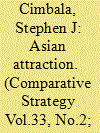

|
|
|
|
|
| Publication |
2014.
|
| Summary/Abstract |
The United States' military-strategic pivot toward Asia is motived by concerns about a rising China, about the increased significance of Asia on the world economic and political stages, and about the growing risks of nuclear proliferation and nuclear first use in that region. Nuclear Asia already numbers five acknowledged or de facto nuclear weapons states among its members: Russia, China, North Korea, India, and Pakistan. Failure to reverse North Korea's nuclear weapons status or political distrust among other powers may increase the number of Asian nuclear weapons states (including states with prospective nuclear-missile reach into Asia) to eight, creating an Asian-Middle Eastern nuclear arms race that defies containment. On the other hand, an alternative presents itself, in the form of a multilateral nuclear arms reduction agreement that would create three tiers of accepted nuclear weapons states and bar the door to new admits.
|
|
|
|
|
|
|
|
|
|
|
|
|
|
|
|
| 2 |
ID:
132001
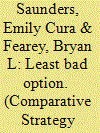

|
|
|
|
|
| Publication |
2014.
|
| Summary/Abstract |
This article examines the merits of extending the U.S. nuclear deterrent to the Middle East. It begins by looking at past practices of such an extension before delving into the overall issues presented by providing such a security guarantee. This article then looks at a brief survey of some of the regional issues facing a nuclear extension before considering the P-5 states and their concerns.
|
|
|
|
|
|
|
|
|
|
|
|
|
|
|
|
| 3 |
ID:
127638
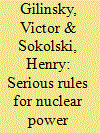

|
|
|
|
|
| Publication |
2014.
|
| Summary/Abstract |
The authors propose five principles for addressing the major deficiencies of the current treaty-based approach to nonproliferation. These involve: effectively closing the door to withdrawals from the Treaty on the Non-Proliferation of Nuclear Weapons (NPT); defining which nuclear technologies fall within the NPT's "inalienable right" provision, so as to maintain a reasonable safety margin against possible military application; expansion of International Atomic Energy Agency inspections to include greater readiness to use its "special" inspection authority; creation of an NPT enforcement regime, to include a secretariat; and universalizing the NPT so as to apply to all states, while creating a path for current non-parties to come into compliance. There is no illusion here about the prospects for the adoption of this approach. At a minimum, the world needs to be frank about the gap between nuclear programs and current nonproliferation protection. Encouragement of greater use of nuclear power should be predicated on closing that gap.
|
|
|
|
|
|
|
|
|
|
|
|
|
|
|
|
| 4 |
ID:
059746
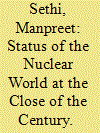

|
|
|
| 5 |
ID:
131591
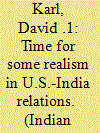

|
|
|
|
|
| Publication |
2013.
|
| Summary/Abstract |
Befitting two raucous democracies, once estranged but increasingly fraternal, the U.S.-India relationship routinely evokes grandiloquence about "natural allies," "an affair of the heart," "kindred spirits," "common DNA" and a defining partnership" shaping the destiny of the 21st century. Such sentiments were on full display in late 2009 when Prime Minister Manmohan Singh visited the White House as President Baraek Obama's first official state guest. In the run-up to the event, Obama declared that Mahatma Gandhi "was a real hero of mine" and let it be known that he considered Singh and India part of his family. The extravagant state dinner staged on the South Lawn was the hottest ticket in town, attracting party crashers to boot, and even the rainy weather did not dim an event the Washington Post likened to a Hollywood production. And with expectations raised by the recently-codified U.S.-India nuclear cooperation agreement, the two leaders spoke augustly about a "future that beckons all of us."'
|
|
|
|
|
|
|
|
|
|
|
|
|
|
|
|